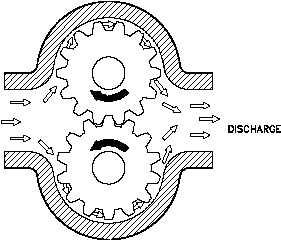POSITIVE DISPLACEMENT PUMPS
DOE-HDBK-1018/1-93
Pumps
Rotary Pumps
Rotary pumps operate on the principle that a rotating vane, screw, or gear traps the liquid in the
suction side of the pump casing and forces it to the discharge side of the casing. These pumps
are essentially self-priming due to their capability of removing air from suction lines and
producing a high suction lift. In pumps designed for systems requiring high suction lift and self-
priming features, it is essential that all clearances between rotating parts, and between rotating
and stationary parts, be kept to a minimum in order to reduce slippage. Slippage is leakage of
fluid from the discharge of the pump back to its suction.
Due to the close clearances in rotary pumps, it is necessary to operate these pumps at relatively
low speed in order to secure reliable operation and maintain pump capacity over an extended
period of time. Otherwise, the erosive action due to the high velocities of the liquid passing
through the narrow clearance spaces would soon cause excessive wear and increased clearances,
resulting in slippage.
There are many types of positive displacement rotary pumps, and they are normally grouped into
three basic categories that include gear pumps, screw pumps, and moving vane pumps.
Simple Gear Pump
There are several variations of
Figure 14 Simple Gear Pump
gear pumps. The simple gear
pump
shown
in
Figure 14
consists of two spur gears
meshing together and revolving in
opposite directions within a
casing. Only a few thousandths
of an inch clearance exists
between the case and the gear
faces and teeth extremities. Any
liquid that fills the space bounded
by two successive gear teeth and
the case must follow along with
the teeth as they revolve. When
the gear teeth mesh with the teeth
of the other gear, the space
between the teeth is reduced, and
the entrapped liquid is forced out
the pump discharge pipe. As the
gears revolve and the teeth disengage, the space again opens on the suction side of the
pump, trapping new quantities of liquid and carrying it around the pump case to the
discharge. As liquid is carried away from the suction side, a lower pressure is created,
which draws liquid in through the suction line.
ME-03
Rev. 0
Page 22

